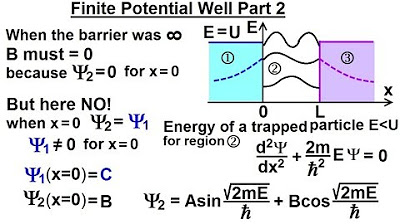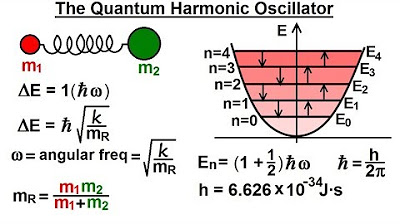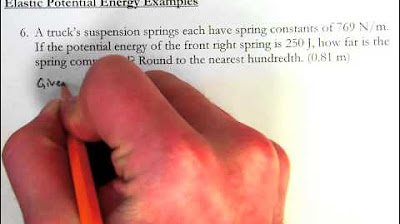Physics - Ch 66 Ch 4 Quantum Mechanics: Schrodinger Eqn (34 of 92) Finite Potential Well Part 3
TLDRThe video script discusses the quantization of energy levels for a particle within a finite potential well. It explains that the wave function in the central region (region 2) must match the exponential decaying functions in the barrier regions (regions 1 and 3). This matching is achieved by setting the argument of the sine or cosine function to multiples of π, resulting in discrete energy levels given by En = (n^2 * π^2 * ħ^2) / (2 * m * L^2), where n is an integer, m is the particle's mass, L is the well's length, and ħ is Planck's constant divided by 2π. These quantized energy levels lead to specific sinusoidal functions within region 2 that are compatible with the decaying functions in the barrier regions.
Takeaways
- 🌟 In a finite potential well, particles can have discrete energy levels determined by the wave function's compatibility across different regions.
- 📐 The general solution for a particle within region 2 (between x=0 and x=L) is defined by a specific equation involving sine or cosine functions.
- 🤔 The wave function in region 2 must match with the exponential decaying functions in regions 1 and 3, which restricts the possible wavelengths to half or full multiples of a wavelength.
- 🌀 The argument of the sine or cosine function must be equal to n times π (where n is an integer) for the wave functions to match at the boundaries.
- 🔢 The energy levels (e_n) inside region 2 are quantized and can be calculated using the equation e_n = (n^2 * π^2 * ħ^2) / (2 * m * L^2), with n being an integer.
- 💫 The square root of 2m * ħ / L must equal n * π for the energy levels to be valid, ensuring the wave function's continuity across the well.
- 🌈 The energy levels are distinct and depend on the particle's mass (m), the well's length (L), and Planck's constant (ħ).
- 📈 The sinusoidal functions inside region 2 are specific and designed to match the exponential decaying functions in the barrier regions.
- 🚧 The particle can reside within the barriers (regions 1 and 3) to a small extent if it has enough energy.
- 📚 The concept is rooted in quantum mechanics, illustrating the particle's behavior in a confined space with potential barriers.
- 🔍 This analysis provides a deeper understanding of quantum states and the quantization of energy levels within a finite potential well.
Q & A
What is the general solution for a particle inside a finite potential well?
-The general solution for a particle inside a finite potential well, specifically in region 2 between x=0 and x=L, is defined by a sine or cosine function.
Why does the function in region 2 have to be a sine or cosine function with specific wavelength multiples?
-The function in region 2 must be a sine or cosine function with a half or full wavelength, or multiples thereof, to ensure that it can match the functions in regions 1 and 3, where the particle can reside to a small extent inside the barriers as long as there is enough energy.
What are the possible values for the argument of the sine or cosine function in region 2?
-The possible values for the argument of the sine or cosine function in region 2 are n times pi (n = 1, 2, 3, ...), which corresponds to 1π, 2π, 3π, etc.
How does the energy of the particle in region 2 relate to the length of the well and the mass of the particle?
-The energy of the particle in region 2 is directly related to the length of the well (L) and the mass of the particle (m) through the equation for the energy levels, given by E_n = (n^2 * π^2 * ħ^2) / (2 * m * L^2), where ħ is Planck's constant divided by 2π.
What is Planck's constant divided by 2π (h-bar), and why is it significant in this context?
-Planck's constant divided by 2π (h-bar) is a fundamental constant in quantum mechanics, significant in this context as it appears in the equation for the energy levels of the particle in a finite potential well, influencing the quantization of energy values.
How do the energy levels inside the finite potential well differ from those in an infinite potential well?
-In an infinite potential well, the energy levels are continuous, whereas in a finite potential well, the energy levels are quantized and discrete, with specific values determined by the mass of the particle, the length of the well, and Planck's constant.
What is the role of the exponential decaying function in regions 1 and 3?
-The exponential decaying function in regions 1 and 3 represents the small probability of finding the particle within the barriers, which is possible due to the particle's wave-like nature and the tunneling effect.
How does the requirement for the function to match across regions 1, 2, and 3 influence the energy levels inside the well?
-The requirement for the wave function to match across all regions ensures that the energy levels inside the well are quantized, leading to distinct energy values for the particle.
What is the significance of the quantization of energy levels in a finite potential well?
-The quantization of energy levels in a finite potential well is a key concept in quantum mechanics, as it demonstrates the discrete nature of energy states that particles can occupy, which is a result of the wave-like behavior of particles.
How does the length of the well (L) affect the energy levels of the particle?
-The length of the well (L) is inversely proportional to the square of the energy levels (E_n), meaning that as the well length increases, the energy levels become smaller, and vice versa.
What happens to the energy levels if the mass of the particle (m) increases?
-If the mass of the particle (m) increases, the energy levels (E_n) will also increase, as the mass is inversely proportional to the energy levels in the equation for the finite potential well.
Outlines
🌟 Quantum Mechanics: Energy Levels in a Finite Potential Well
This paragraph delves into the concept of energy levels within a finite potential well, focusing on the quantization of energy for a particle. It explains that the general solution for a particle's energy inside region 2 (between two barriers) is defined by a specific equation. The discussion highlights the necessity for the wave function to match across regions 1, 2, and 3, leading to the conclusion that the argument of the sine or cosine function must be a multiple of pi (1 PI, 2 PI, 3 PI, etc.). This quantization condition is crucial for the wave function inside region 2 to align with the exponential decaying functions in regions 1 and 3. The energy levels are determined by the particle's mass, the well's length, and Planck's constant, resulting in distinct sinusoidal equations for region 2 that correspond to the energy values the particle can possess.
Mindmap
Keywords
💡Energy
💡Finite Potential Well
💡Sine and Cosine Functions
💡Wavelength
💡Quantization
💡Boundary Conditions
💡Exponential Decaying Function
💡Argument of a Function
💡Planck's Constant
💡Mass
💡Wave Function
Highlights
The general solution for a particle inside a finite potential well is defined by a specific equation.
The function in region 2 is a sine or cosine function, related to the width of the well and the energy levels.
The length of region 2 should correspond to a half or full wavelength for the function to match with regions 1 and 3.
The particle can reside inside the barriers if there is enough energy, leading to specific energy values for the particle.
The argument of the sine or cosine function must be a multiple of pi (1 PI, 2 PI, 3 PI, etc.) for the functions to match up.
The energy levels are quantized and depend on the mass of the particle, the length of the well, and Planck's constant.
The equation for energy levels inside the well is given by e_n = (n^2 * pi^2 * h-bar^2) / (2 * m * L^2).
The energy values are distinct and determined by the particle's mass, the well's length, and Planck's constant.
The sinusoidal functions inside region 2 match with the exponential decaying functions in regions 1 and 3.
The particle's energy levels inside region 2 are the only possible values it can have in a finite potential well.
The mathematical model explains the quantization of energy levels in a finite potential well scenario.
The theoretical framework has practical applications in quantum mechanics and understanding particle behavior.
The discussion provides a clear understanding of wave functions and their relation to energy levels in quantum systems.
The energy levels are directly related to the particle's wave function, which must satisfy boundary conditions.
The video content serves as an educational resource for those interested in quantum physics and potential well problems.
The mathematical derivations and explanations are essential for students and researchers in the field of quantum mechanics.
The video presents a comprehensive analysis of the particle in a finite potential well, a fundamental concept in quantum mechanics.
The energy quantization is a direct result of the wave nature of particles and the imposed boundary conditions.
The video's content is a valuable resource for anyone seeking to understand the behavior of particles in potential wells.
Transcripts
Browse More Related Video

Physics - Ch 66 Ch 4 Quantum Mechanics: Schrodinger Eqn (33 of 92) Finite Potential Well Part 2

Physics - Ch 66 Ch 4 Quantum Mechanics: Schrodinger Eqn (22 of 92) Prob. of Finding Particle 2

Physics - Ch 66 Ch 4 Quantum Mechanics: Schrodinger Eqn (39 of 92) What is the Quantum Oscillator?

Physics - Ch 66 Ch 4 Quantum Mechanics: Schrodinger Eqn (25 of 92) Prob. of a Particle 1-D Box n=1

Elastic Potential Energy - Introductory Example Problems

Physics - Ch 66 Ch 4 Quantum Mechanics: Schrodinger Eqn (19 of 92) Particle in 1-D Box: Example 1/2
5.0 / 5 (0 votes)
Thanks for rating: